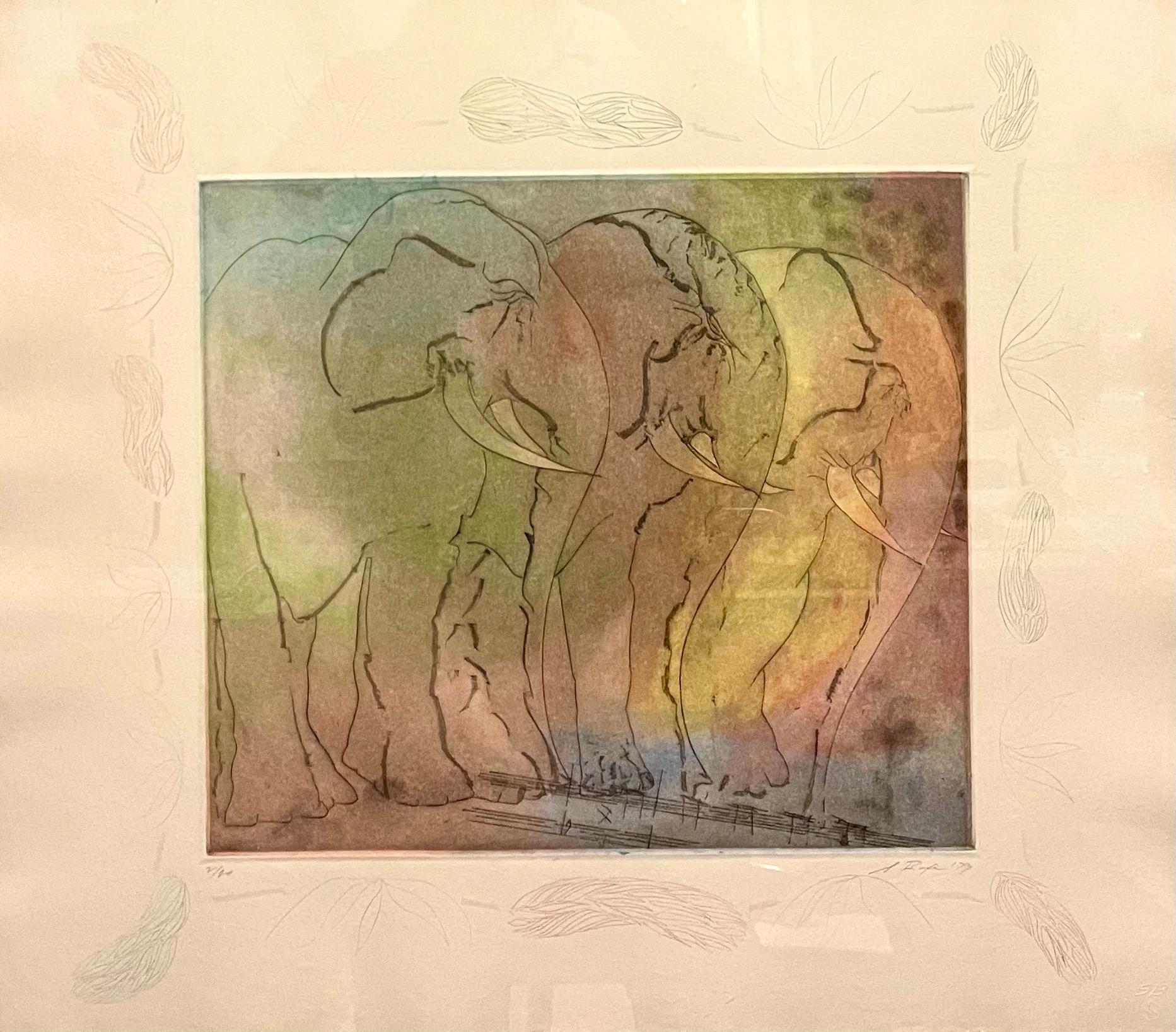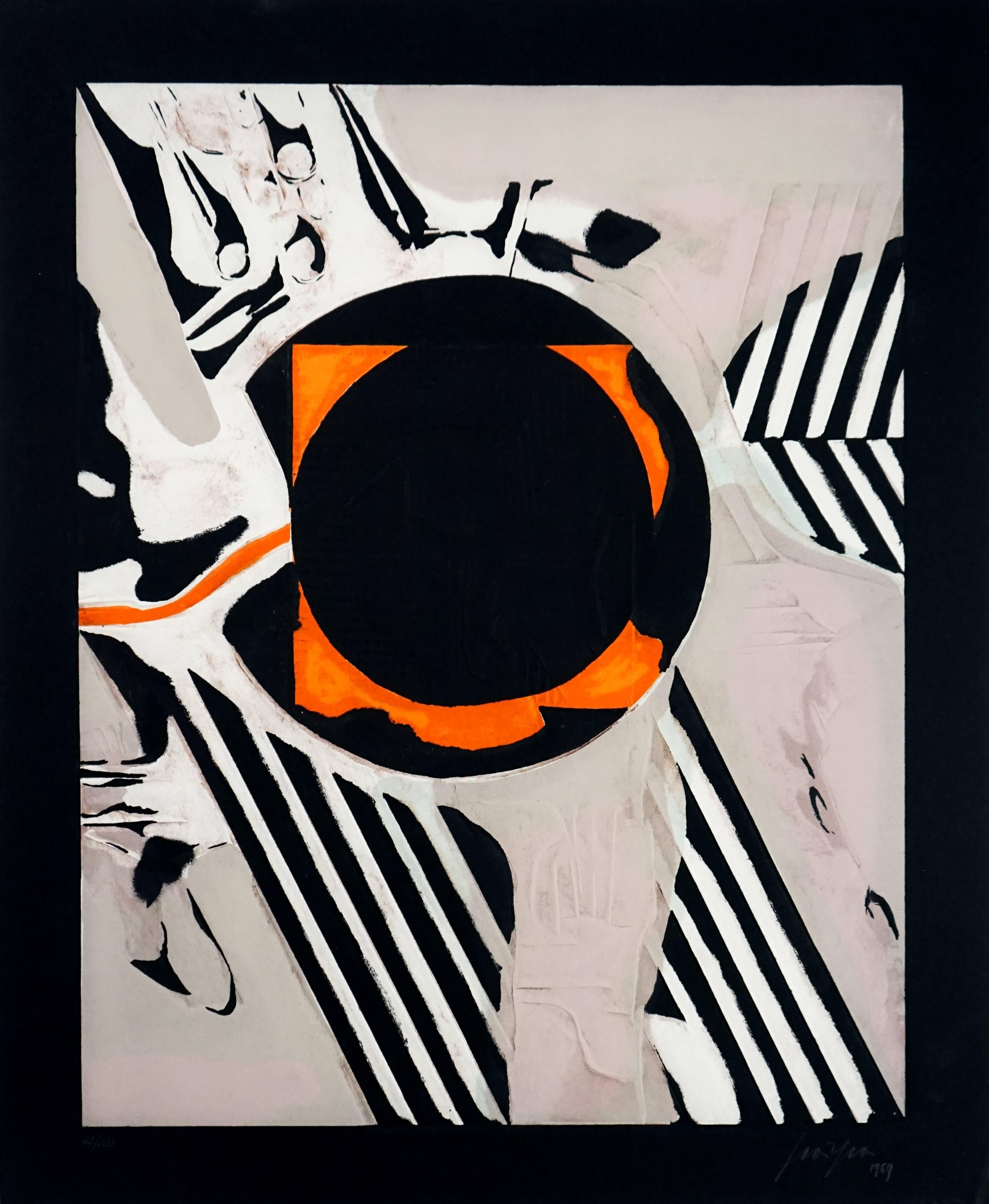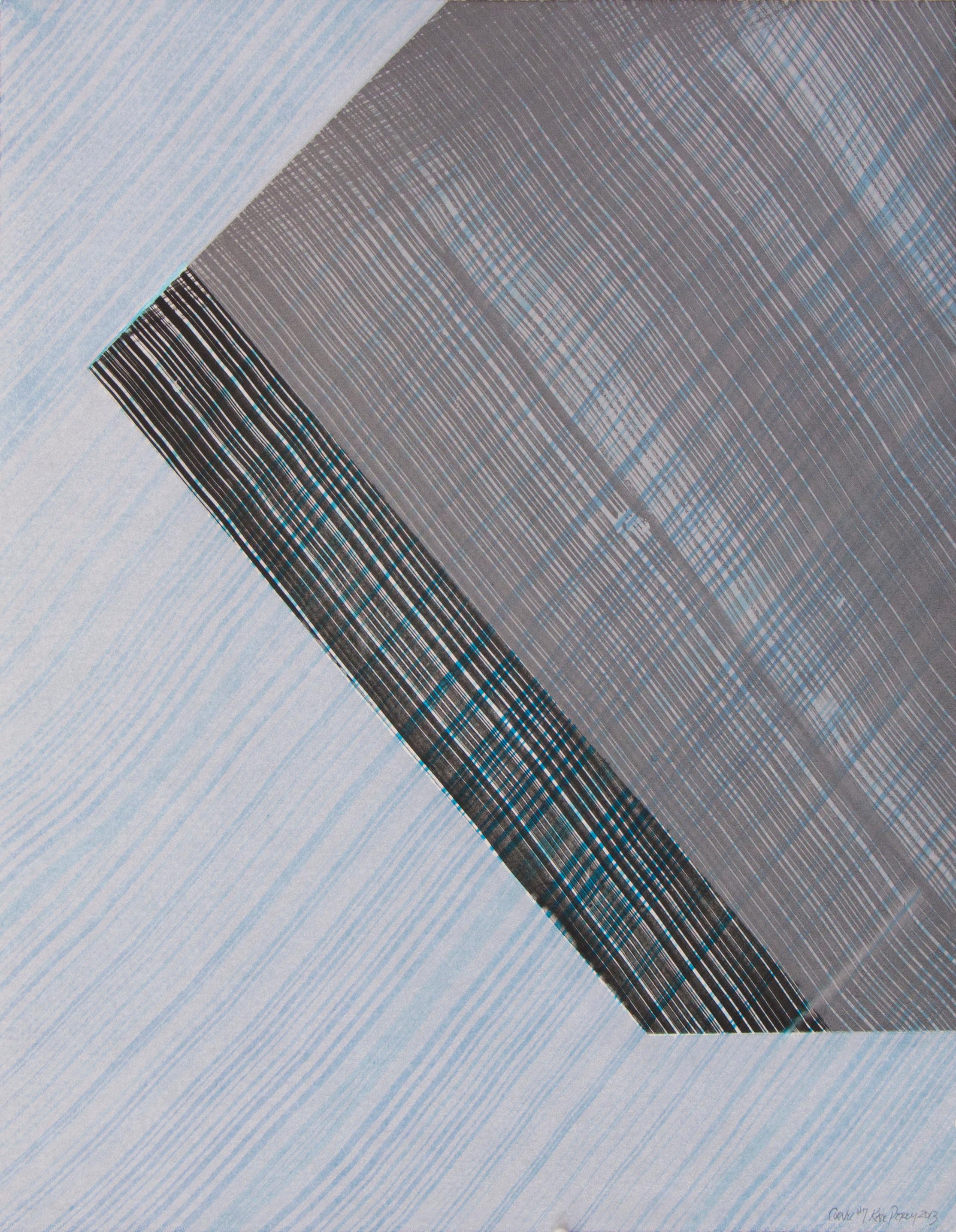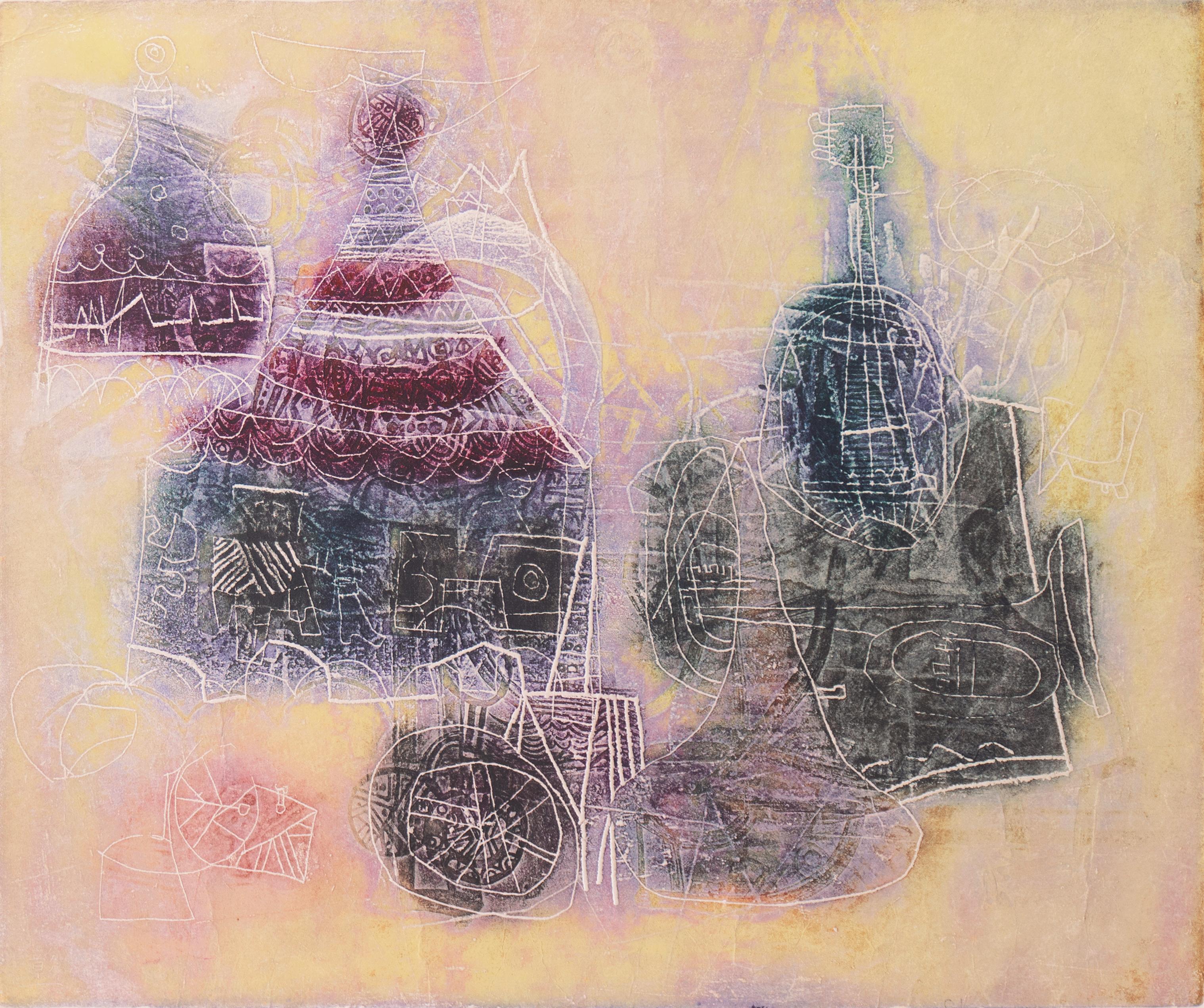Items Similar to Untitled
Want more images or videos?
Request additional images or videos from the seller
1 of 2
Bernard ChildsUntitled1960
1960
About the Item
Signed, dated, annotated "epreuve d'artiste"; Annotated on titled "B.B."
Edition: 5
References And Exhibitions:
One of the three impressions printed on ARCHES watermark paper
Intaglio printed in orange/red with gold or copper flecks in the ink
Bernard Childs (1910-1985)
Bernard Childs (1910–1985) was an artist who worked in Paris and New York. He was primarily a painter and printmaker, and pioneered the direct engraving of metal plates with power tools. As a kind of counterpoint to his many-layered work, which is often symbolic and a fusion of abstraction and figuration, in 1959 he also started painting portraits. Childs' formal interests were line and space, light and color, and the dialogue of contrasting elements.
Life
Childs wrote, "My work is to make pictures." He first found his vocation in high school, in Harrisburg, Pennsylvania where his Russian immigrant parents had moved the family from his birthplace, Brooklyn. During her last days, his mother told him he was the seventh generation of artists in the family, his forebears having been painters of icons in the churches of Yaroslav.
In 1928, a scholarship took him to the University of Pennsylvania. He left two years later for New York where he worked by day and studied at night with Kimon Nicolaїdes at The Art Students League in New York. He also had the luck to meet the great Danish silversmith Peer Smed, from whom he learned his love of metal.
The economic and social problems of the 1930s took Childs away from his work as an artist, until he began drawing again in the South Pacific while serving as a quartermaster aboard the destroyer escort USS Wesson, during World War II. Childs survived a Kamikaze attack and, at war's end, two years of intermittent hospitalization after returning to New York. His recovery was complete by 1947, the year he studied with Amédée Ozenfant, who became a good friend. In 1951, thanks to the G.I. Bill, he sailed for Italy where he began his full-time life as an artist. It was there that he met and became friends with Alberto Burri and Enrico Baj.
Following a year in Perugia and in Rome and his first solo exhibition, at the venerable Galleria dell'Obellisco, Childs settled in Paris, realizing his first mature painting at age 42 and quickly becoming part of the European vanguard. He was included in many exhibitions of the Paris salons, various galleries such as Ariel and Iris Clert, Galerie Parnass in Wuppertal and the free floating group Phases along with Alechinsky, Baj, Cousins, Ernst, Fahlström, Fontana, Lam, Jaffe, Pederson, Soulages, Yasse Tabuchi, and Tajiri. He was championed by the French art critics Pierre Restany and Édouard Jaguer, and the Swedish art historian and curator Ragnar von Holten.
By 1959 he was in Documenta II and had his first solo museum exhibition, of paintings and prints, at the Stedelijk Museum in Amsterdam. It was in early 1955, after a month in December 1954 at Atelier 17, that he had signed his first editions of prints and begun pioneering the direct engraving of metal plates with power tools for which he is well recognized. Childs was also one of the first post World War II Western artists invited to show in Japan where he had two exhibitions, of paintings and of prints in 1960 and 1961 respectively at the Tokyo Gallery, and received the Museum of Western Art Award at the 1961 Tokyo International Print Biennial.
From 1966 to 1977, Childs commuted between his Paris studio and his New York studio at the Hotel Chelsea. In 1969, a retrospective of his 1960's paintings, prints and engraved acrylic light sculptures was held at the Storm King Art Center in Mountainville, NY. This exhibition was the occasion for the first public view of his light sculptures – laminates of engraved sheets of acrylic lit from below – an experiment with light and color that he began the same year and continued through part of the 1970s.[2] Although a stroke in 1978 interrupted his career, Childs never stopped drawing and soon resumed painting, remaining in New York until his death at age 74 in March 1985.
Although he exhibited extensively in group shows, Childs was essentially a loner. A renowned curator once called him a "rogue artist", one who cannot be defined by a category, a group, or a decade. Often a fusion of abstraction and figuration, at times paralleled by portraiture, his is a body of work rooted in the second half of the 20th century and whose ongoing appeal defies time.
Formal interests and underlying stories
Underlying Childs' art is a story of survival – of war, of environmental disaster – expressed with consummate craftsmanship and an ever renewed search and invention in many mediums. Ancient insect species became a favorite symbol of survival.[3] He drew their movements and strength up close and even sent them in his 1970's paintings to explore outer space for a new home, should planet Earth no longer support life. Survival of the planet and above all, survival of life in no matter what form it took, was a big concern. Creation myths, world myths, certain literary myths were close to his heart.
Childs' formal concerns were line and space, light and color, and the dialogue of contrasting elements related in time but often projecting different spatial environments. Portraiture and figuration of one kind or another are ever present, overtly or woven into abstractions. Childs took a sensual pleasure in his materials and a sensual, witty approach to many of the visual stories he told. His erotic stories of love are tender and sometimes funny. Danger is reflected in both his memories of war and his warnings of future dangers such as nuclear holocaust.
Selected public collections
• Bibliothèque nationale de France, Paris
• Ishibashi Foundation, Tokyo (formerly the Bridgestone Gallery)
• Brooklyn Museum, Brooklyn, New York
• Grey Art Gallery, New York University, New York
• Hood Museum of Art, Hanover, New Hampshire
• Israel Museum, Jerusalem
• Metropolitan Museum of Art, New York
• Museum of Fine Arts, Boston
• Moderna Museet, Stockholm
• National Portrait Gallery, Stockholm
• National Portrait Gallery, Washington, DC
• The National Museum of Western Art, Tokyo
• Princeton University Museum of Art, Princeton, New Jersey
• San Francisco Fine Arts Museums, Palace of the Legion of Honor, Achenbach Foundation for Graphic Arts
• Smith College Museum of Art & the Mortimer Rare Book Room, Northampton, Massachusetts
• Stedelijk Museum, Amsterdam
• The Hyde Collection, Glens Fall, New York
• The Library of Congress, Washington D.C.
• The Butler Institute of American Art, Youngstown, Ohio
• The Jane Voorhes Zimmerli Art Museum, Rutgers, New Brunswick, New Jersey
• Whitney Museum of American Art, New York
• Worcester Art Museum, Worcester, Massachusetts
• Yale University Art Museum, New Haven, Connecticut
• The Harvard Art Museums, Cambridge, Massachusetts
- Creator:Bernard Childs (1910 - 1985, American)
- Creation Year:1960
- Dimensions:Height: 11.13 in (28.28 cm)Width: 7.88 in (20.02 cm)
- Medium:
- Movement & Style:
- Period:
- Condition:
- Gallery Location:Fairlawn, OH
- Reference Number:
About the Seller
5.0
Recognized Seller
These prestigious sellers are industry leaders and represent the highest echelon for item quality and design.
Platinum Seller
These expertly vetted sellers are 1stDibs' most experienced sellers and are rated highest by our customers.
Established in 1978
1stDibs seller since 2013
718 sales on 1stDibs
Typical response time: 1 hour
Associations
International Fine Print Dealers Association
- ShippingRetrieving quote...Ships From: Fairlawn, OH
- Return PolicyA return for this item may be initiated within 10 days of delivery.
More From This SellerView All
- B.B.By Bernard ChildsLocated in Fairlawn, OHSigned, dated, annotated "epreuve d'artiste"; Annotated on titled "B.B." Edition: 5 (5/5) Part of a set of 4 prints commissioned for a book Childs did with the German writer Bazon ...Category
1960s Abstract Abstract Prints
MaterialsIntaglio
- Glowing TreeBy Gabor F. PeterdiLocated in Fairlawn, OHGlowing Tree Etching, engraving & lift ground, 1958 Signed, titled and annotated in pencil (see photos) Edition: Artist Proof (there was a published addition of 30 with five stencil ...Category
1950s American Modern Abstract Prints
MaterialsIntaglio
- Tommy's PondBy Gabor F. PeterdiLocated in Fairlawn, OHSigned, dated and numbered in pencil Edition: 100 plus fifty Roman numeral Sheet: 20 1/16 x 14 7/16"; Plate: 13 7/8 x 10 7/8"Category
1960s Abstract Prints
MaterialsIntaglio
- Terres de Grand Feu, (Land of Great Fire)By Joan MiróLocated in Fairlawn, OHDerriere le miroir, no. 87-88-89. Pages 6-7 Terres de Grand Feu, (Land of Great Fire) Color lithograph, 1956 From: Derriere le Miroir, Volume 87-8...Category
1950s Abstract Abstract Prints
MaterialsLithograph
- MereBy Stanley William HayterLocated in Fairlawn, OHMere Etching and soft ground, 1970 Signed, dated, titled and numbered in pencil Printed in colors by Hector Saunier on BFK Rives paper Published by Georgetown Graphics, Washington, D...Category
1970s Abstract Abstract Prints
MaterialsEtching
- Derriere Le Miroir-Page 6-7By Alexander CalderLocated in Fairlawn, OHDerriere Le Miroir-Page 6-7 Color lithograph, 1973 Unsigned (as issued) From: Derriere Le Miroir, No. 201, January 1973 Publisher: Maeght Editeur, Paris Printer: L’Imprimerie Arte, Adrien Maeght Edition: Large (unspecified) There is also a deluxe edition of this issue of DLM, signed and numbered on the justification page, edition 150 Condition: Fresh colors a few spots of foxing near the centerfold, appropriate to it's age Sheet/Image size: 15 x 22 inches Derriere le Miroir (Behind the Mirror) The art...Category
1970s Abstract Abstract Prints
MaterialsLithograph
You May Also Like
- Stanley Boxer Aquatint Intaglio Etching Elephant Herd Abstract ExpressionistBy Stanley BoxerLocated in Surfside, FLElephants. 1979 edition 2/20 Hand signed and dated Framed 24.5 X 28. Sheet 23 X 26 This is from a series of prints Boxer produced at Tyler Graphics between 1975 and 1979. Over this period, he created several series of intricately rendered figurative works, illustrating whimsical scenes featuring animals, plants and nubile winged figures. Boxer had, however, been making drawings of this nature throughout his career, and he insisted they were closely connected to his abstracts, made with similar gestures and motivation. The Tate Museum received twenty-five of Stanley Boxer’s prints as a gift of Kenneth Tyler from Tyler Graphics, comprising a complete portfolio of Ring of Dust in Bloom, 1976, an incomplete portfolio of Carnival of Animals, 1979, and two individual prints. This work is from Carnival of Animals, a portfolio of fourteen intaglio prints on handmade paper. Tate holds eleven of the prints from this portfolio (Elephants, Swan and Fossils are not in Tate’s collection). Stanley Boxer (1926-May 8, 2000) was an American abstract expressionist artist best known for thickly painted abstract works of art. He was also an accomplished sculptor and printmaker. He received awards from the Guggenheim Fellowship and the National Endowment for the Arts. Boxer was born in New York City, and began his formal education after World War II, when he left the Navy and studied at the Art Students League of New York. He drew, painted, made prints, and sculpted. His work was recognized by art critic Clement Greenberg, who categorized him as a color field painter, A group that included Barnett Newman, Clyfford Still, and Mark Rothko and was a form of Abstract Expressionism and later included Helen Frankenthaler, Ad Reinhardt, Kenneth Noland, Gene Davis, Jules Olitski, Raymond Parker and Morris Louis. Boxer himself was adamant in rejecting this stylistic label. Over the years, he remained loyal to the materially dense abstract mode on which his reputation rested.. Art critic Grace Glueck wrote "Never part of a movement or trend, though obviously steeped in the language of Modernism, the abstract painter Stanley Boxer was a superb manipulator of surfaces, intensely bonding texture and color." In 1953 Boxer had his first solo exhibition of paintings in New York City, and showed regularly thereafter until his death. His paintings and sculpture were represented in New York City during the late 1960s through 1974 by the Tibor de Nagy Gallery, then by the André Emmerich Gallery from 1975 until 1993, and finally by Salander-O'Reilly Galleries until its demise in 2007. Richard Waller, director of the University of Richmond's Harnett Museum of Art, describes his evolution as an artist: You can see the shift from working with figurative imagery in the 1940s and early '50s to abstraction in the late '50s. The abstraction in the late '60s and '70s was more derived from color-field issues. In the 1980s, Boxer really hit his stride in larger works with lots of thick paint and splashes of color. He sold a lot, and his success in the art world in the 1980s gave him the freedom to do what he wanted to do most. He was married to painter and artist Joyce Weinstein. The Boca Raton Museum of Art in Florida hosted an exhibition entitled Expanding Boundaries: Lyrical Abstraction Selections from the Permanent Collection. At the time the museum issued a statement that said in part: "Lyrical Abstraction arose in the 1960s and 70s, following the challenge of Minimalism and Conceptual art. Many artists began moving away from geometric, hard-edge, and minimal styles, toward more lyrical, sensuous, romantic abstractions worked in a loose gestural style. These "lyrical abstractionists" sought to expand the boundaries of abstract painting, and to revive and reinvigorate a painterly 'tradition' in American art. "Characterized by intuitive and loose paint handling, spontaneous expression, illusionist space, acrylic staining, process, occasional imagery, and other painterly techniques, the abstract works included in this exhibition sing with rich fluid color and quiet energy. Works by the following artists associated with Lyrical Abstraction will be included: Natvar Bhavsar, Stanley Boxer, Lamar Briggs, Dan Christensen, David Diao, Friedel Dzubas, Sam Francis, Dorothy Gillespie, Cleve Gray, Paul Jenkins, Ronnie Landfield, Pat Lipsky, Joan Mitchell, Robert Natkin, Jules Olitski, Larry Poons, Garry Rich, John...Category
1970s Abstract Expressionist Animal Prints
MaterialsEtching, Aquatint, Intaglio
- Untitled 148By Gino ScarpaLocated in Austin, TXArtist: Gino Scarpa, Italian/Norwegian (1924 - ) Title: Untitled 148 Year: circa 1970 Medium: Aquatint Etching and Carborundum Intaglio print Signed and numbered in pencil, Numbe...Category
1970s Abstract Expressionist Abstract Prints
MaterialsEtching, Aquatint, Intaglio
- Upside 1By Kate PetleyLocated in Bloomington, IL"Upside 1" is a unique monoprint. The artist's graphite drawing made on translucent film was etched into a copper plate using the technique of photogravure, and the plate became a re...Category
21st Century and Contemporary Abstract Geometric Abstract Prints
MaterialsPhotogravure, Monotype
- Corner 7By Kate PetleyLocated in Bloomington, IL"Corner 7" is a unique monoprint. The artist's ink drawing made on translucent film was etched into a copper plate using the technique of photogravure, and the plate became a repeata...Category
21st Century and Contemporary Abstract Geometric Abstract Prints
MaterialsWatercolor, Photogravure, Monoprint
- 'Le Chapiteau et la Guitare', Paris, Atelier 17, Tokyo, NYMOMA, V&A, BenezitLocated in Santa Cruz, CASigned lower right in graphite, 'Shoichi Hasegawa 長谷川 彰一' (Japanese-French, born 1929), titled lower center, 'le chapiteau et la guitare', with number...Category
Late 20th Century Abstract Abstract Prints
MaterialsMulberry Paper, Engraving, Intaglio
- Présence /// French Contemporary Abstract Expressionist Engraving Colorful ArtBy Serge HelenonLocated in Saint Augustine, FLArtist: Serge Helenon (French, 1934-) Title/Portfolio: "Présence" *Each work is signed by Helenon in pencil lower left Year: 1985 Medium: The Complete Portfolio of Three Original Car...Category
1980s Abstract Expressionist Abstract Prints
MaterialsHandmade Paper, Engraving, Intaglio
Recently Viewed
View AllMore Ways To Browse
Vintage Childs Room
Outer Space Vintage
Japanese Erotic Print
Parents And Child Sculpture
Japanese Mother With Child
Night Light Child
D G Denmark
Metal Plate Engraved B
The Escort
Japanese Woven Sculpture
Jane Smith
Planet Earth Vintage
C G Evers
Iris Plate
Mother And Child Sculpture 1969
Orange Japanese Plates
Storm Painting Western
Japanese Painting Irises





